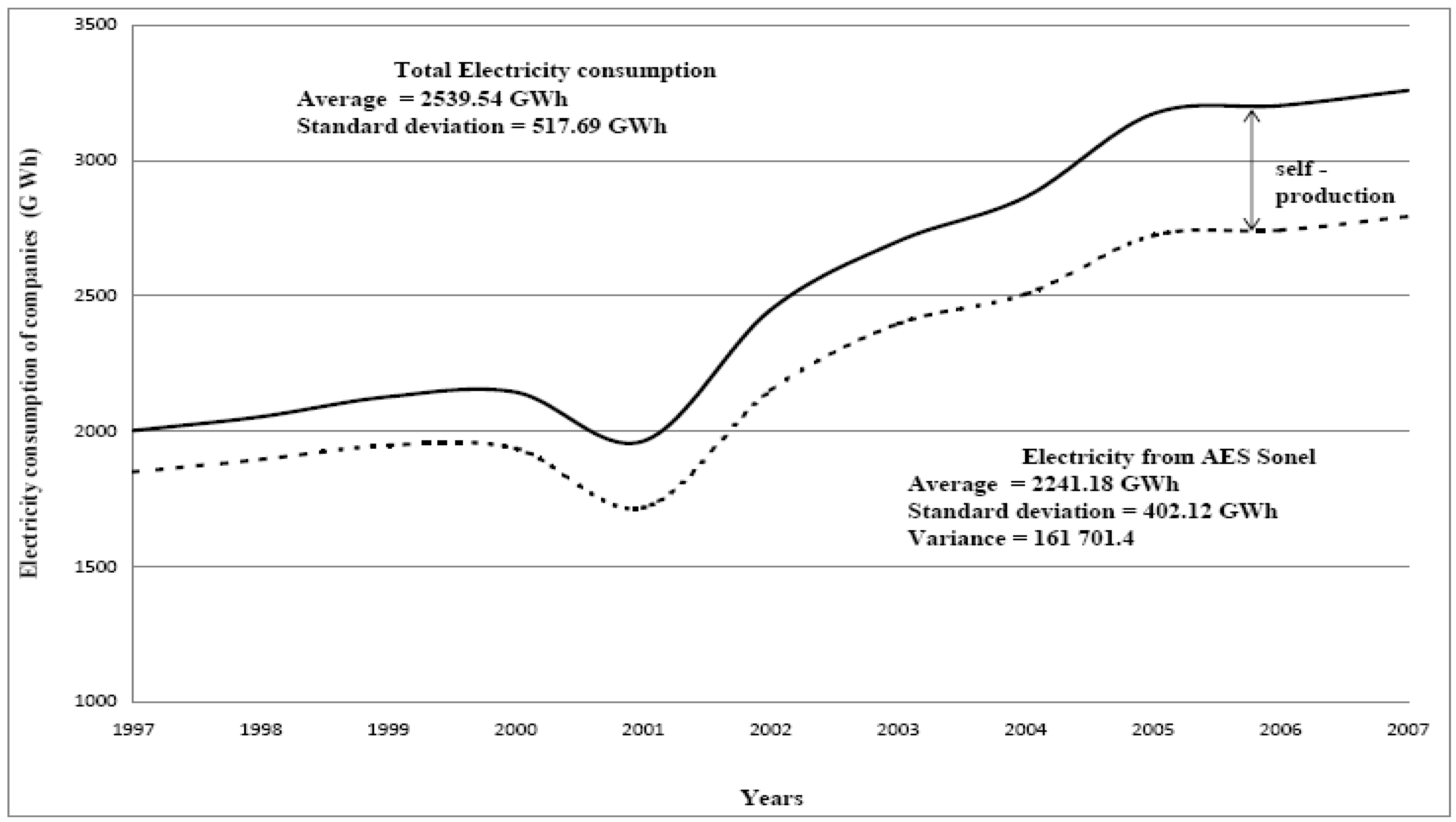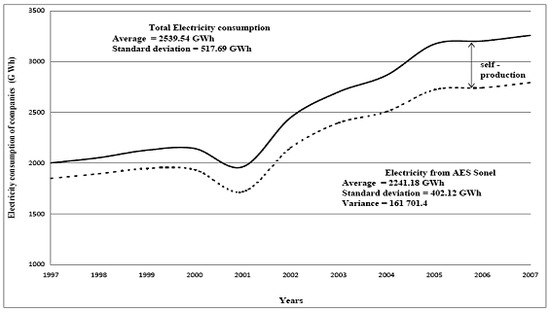Appendix 1a.
Evolution of electricity production units of AES-SONEL (Unit: MW), (Sources: AES-SONEL, NIS, Arsel).
Appendix 1a.
Evolution of electricity production units of AES-SONEL (Unit: MW), (Sources: AES-SONEL, NIS, Arsel).
| Production unit | Years |
|---|
| 2000 | 2001 | 2002 | 2003 | 2004 | 2005 | 2006 | 2007 |
|---|
| HYDROELECTRIC |
| Edea | 263 | 263 | 263 | 263 | 263 | 263 | 263 | 263 |
| Songloulou | 384 | 384 | 384 | 384 | 384 | 384 | 384 | 384 |
| Lagdo | 72 | 72 | 72 | 72 | 72 | 72 | 72 | 72 |
| THERMAL |
| Limbe (HFO) | - | - | - | - | 85 | 85 | 85 | 85 |
| Oyomabang I(HFO) | - | - | - | - | 19.5 | 19.5 | 19.5 | 19.5 |
| Other Units (Gasoline) | 118 | 131 | 156 | 114 | 101.5 | 101.5 | 101.5 | 101.5 |
| Total installed power | 837 | 850 | 875 | 833 | 925 | 925 | 925 | 925 |
Appendix 1b.
Evolution of the electricity transportation lines of AES-SONEL (Unit: km), (Sources: AES-SONEL, Arsel, NIS).
Appendix 1b.
Evolution of the electricity transportation lines of AES-SONEL (Unit: km), (Sources: AES-SONEL, Arsel, NIS).
| No | Voltage | Years |
|---|
| 2000 | 2001 | 2002 | 2003 | 2004 | 2005 | 2006 | 2007 |
|---|
| High tension lines |
| 1 | 225kV | 480 | 480 | 480 | 480 | 480 | 480 | 480 | 480 |
| 2 | 110kV | 337 | 337 | 337 | 337 | 337 | 337 | 337 | 337 |
| 3 | 90kV | 1194 | 1194 | 1194 | 1194 | 1206 | 1206 | 1206 | 1211 |
| Medium tension lines |
| 4 | 15kV | 10 316 | 10 392 | 10 640 | 10 621 | 10 744 | 11 135 | 11 268 | 11 863 |
| Low tension lines |
| 5 | Less than 15kV | 10 117 | 10 116 | 10 243 | 10 330 | 10 560 | 10 736 | 12 138 | 13 472 |
| TOTAL | 22 334 | 22 519 | 22 894 | 22 962 | 23 326 | 23 893 | 25 428 | 27 362 |
Appendix 2.
Questionnaire D’enquete Statistique.
Appendix 2.
Questionnaire D’enquete Statistique.
QUESTIONNAIRE D’ENQUETE STATISTIQUE
For the attention of the General Manager
Dear Sir,
We are carrying out a survey within a sample of industrial companies in Cameroon. The purpose of this research work is to assess the impact of electricity self-generation. Your company has been included in the representative sample, constructed for data collection. This is why this questionnaire has been given to you. We can assure you of the confidential nature of the study and guarantee that the information you will provide will be treated in strict anonymity and used only for academic purposes.
Thank you in advance for your cooperation.
Yours faithfully,
I-1) IDENTIFICATION OF THE SURVEY UNIT
Company name: ………………… Tel/Fax………………
Company sector: ………………….
Company address ……………….
Name of the respondent ………... Tel/Fax………………
Title of the respondent ………….. Name of the interviewer………………….
Date questionnaire was handed in …………… Date of return of the questionnaire ………
I-2) ELECTRIC ENERGY SUPPLY
1. Type of subscription ………………. high tension medium tension
Subscription load ……………………….. (kW )
Number of transformers ………………………
- -
(specify the capacity of transformers)
Transformer n°1 …………….. (kva) Transformer n°2 ……………... (kVa)
Transformer n°3 ……………... (kva)
2. Consumption beyond the annual subscription load ……………….. (kW)
Average power factor (cosφ) ………
Average total energy consumed/month ………………….. (in kWh)
Average amount of electricity bills/month ………………. (in €)
Note: Please, provide a photocopy of an electricity bill or any other useful technical document.
3. Has your company experienced power outage in the last 12 months?
No
![Energies 03 01353 i001]()
Yes
![Energies 03 01353 i001]()
If yes:
How many power outages did you experienced in the last 12 months?
What percentage of your production losses can be attributed to electricity deficit?
(Tick one of the percentages below)
4. How long time you wait for the power to be restored after a power outage before the costs to your company become significant?
5. What type of power outage is most occurred?
Long time
![Energies 03 01353 i003]()
Short time
![Energies 03 01353 i003]()
6. In the last three years, do you think the quality of AES-SONEL electricity supply has: (Choose only one item)
Improved
![Energies 03 01353 i001]()
Stayed the same
![Energies 03 01353 i001]()
Declined
![Energies 03 01353 i001]()
I-3) SELF-GENERATION OF ELECTRICITY
1 What are the means used by your company for self-generation?
Generators
![Energies 03 01353 i004]()
Biomass
![Energies 03 01353 i004]()
2 In case you use generators, please answer the following questions:
How many generators do you use for self-generation? ..................
NB: For each generator, please indicate:
The capacity of the generator…………… The working time per year………...
Hourly consumption of fuel…………….. Quantity of energy produced……….
Quantitiues of lubricant consumed………. Date the generator started working …………
Purchasing price of the generator………….
3 Maintenance of generators
Have you recruited new staff for self-generation purposes?......
If yes, indicate their number and the monthly salary of each.
Have you signed a maintenance contract with a specialized company ?
a) No
![Energies 03 01353 i001]()
b) Yes
![Energies 03 01353 i001]()
If yes:
What is the amount disbursed each year for the maintenance of your generators and other self-generation equipment?.............................(€ )
4. Production recovered due to self-generation
What percentage of the production is recovered due to self-generation of electricity?
(Tick one of the percentages below)
![Energies 03 01353 i002]()
5. Emission of pollutants due to self-generation
Have you analysed the gases emitted during electricity self-generation activities yet?
Yes
![Energies 03 01353 i003]()
No
![Energies 03 01353 i003]()
If yes, please provide us with analysis reports.
Indicate the quantity of waste sent out………………………………
Do you carry out the recycling of used oil and other lubricants originating from self-generation?
Yes
![Energies 03 01353 i003]()
No
![Energies 03 01353 i003]()





 Short time
Short time 



 Biomass
Biomass 



 No
No 
 No
No 





